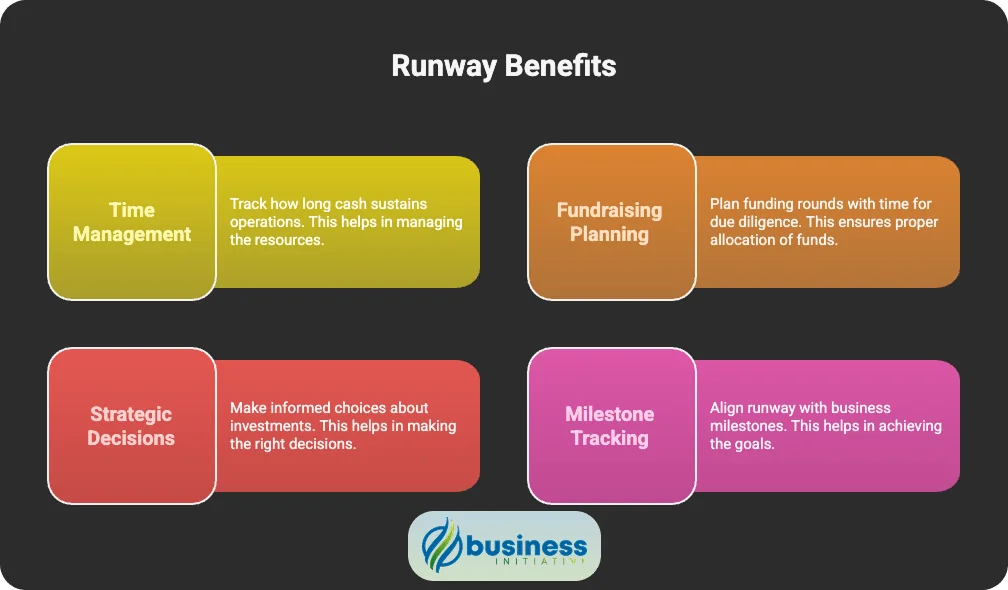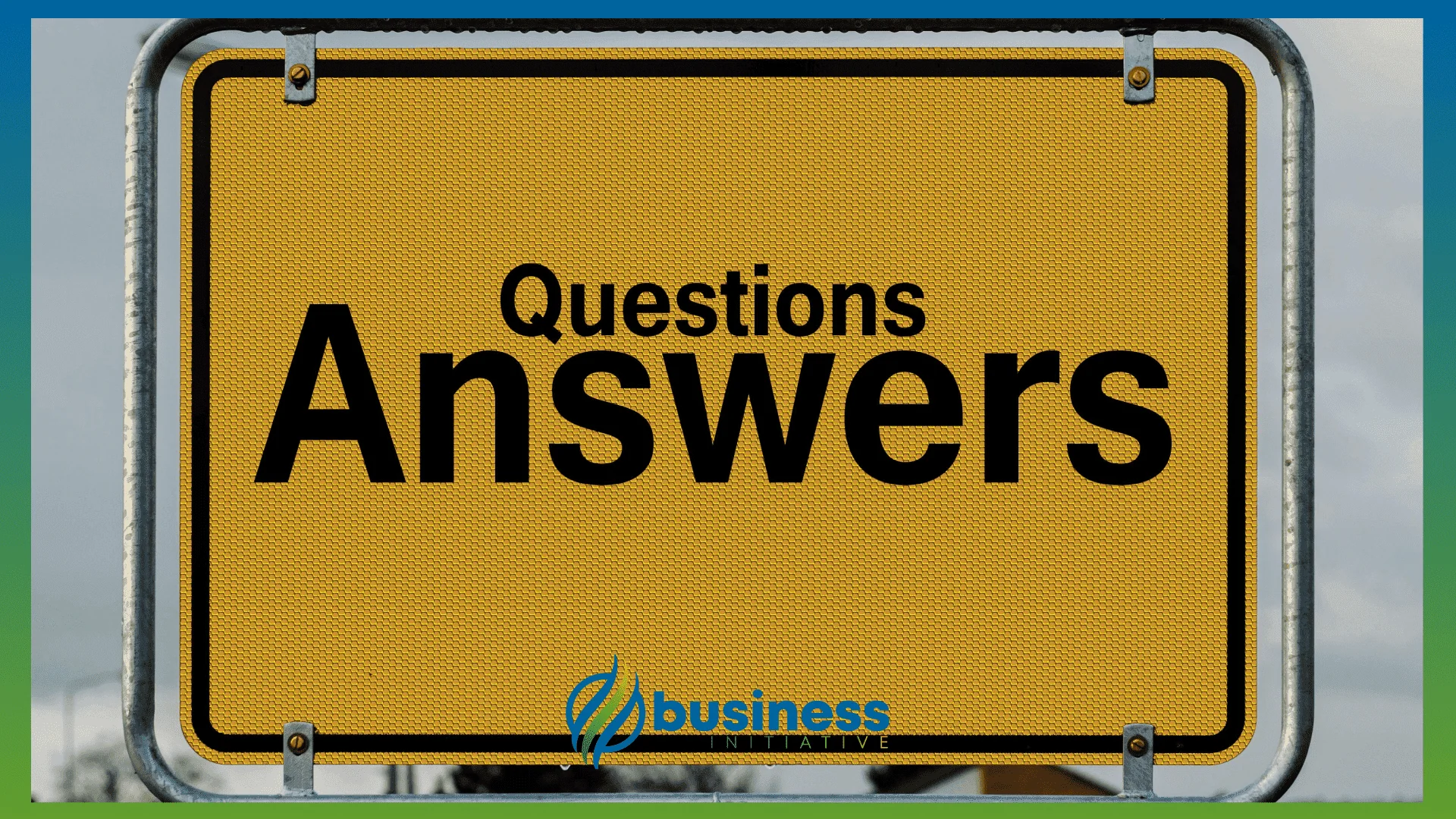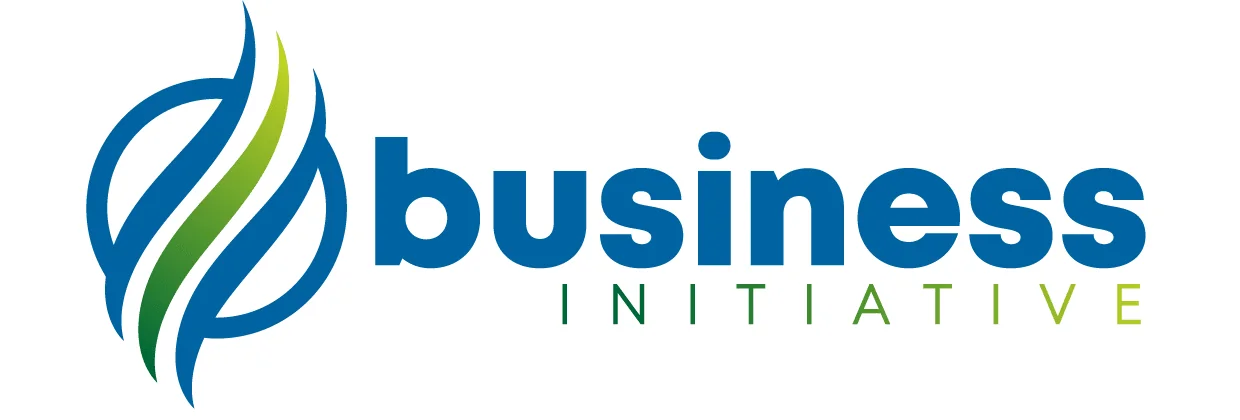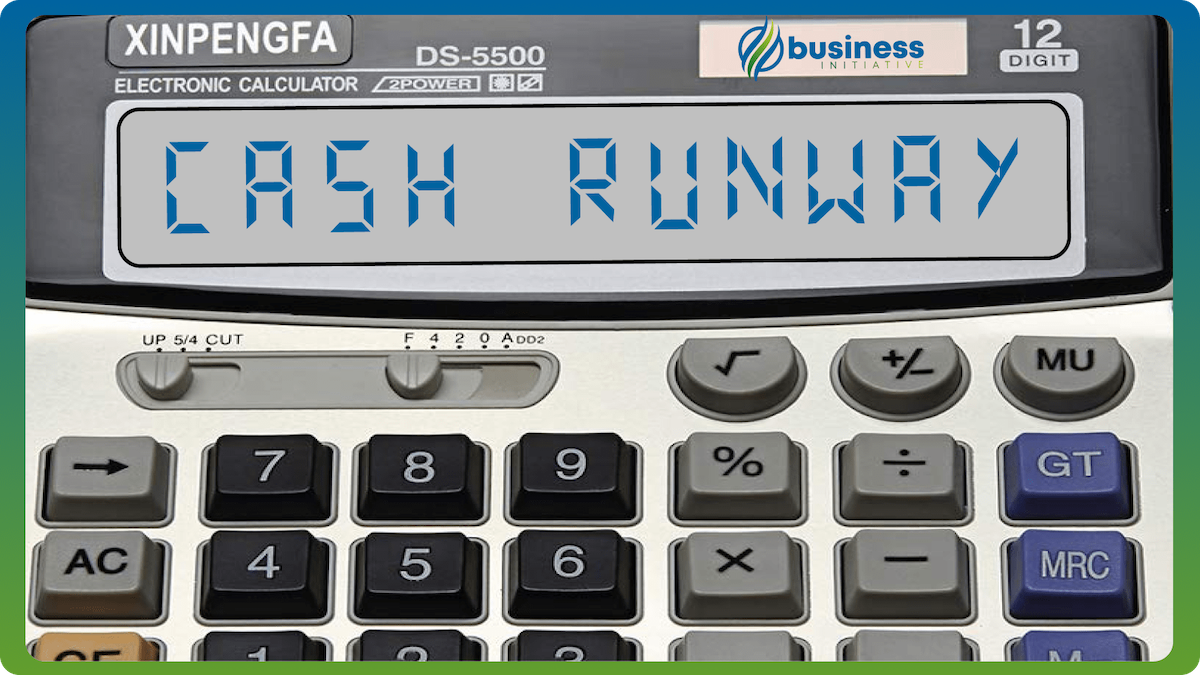Your startup’s runway is perhaps the most critical metric determining your company’s survival and success. Runway represents the lifeline between your current position and either profitability or your next funding round, making it essential for strategic planning, investor communications, and operational decision-making.
Whether you’re a first-time founder trying to understand cash flow dynamics, a seasoned entrepreneur planning your next funding round, or an investor evaluating portfolio companies, accurate runway calculations provide the foundation for making informed decisions about growth, hiring, marketing spend, and fundraising timing.
Our comprehensive runway calculator not only determines how long your cash will last but also provides strategic insights, warning systems, and actionable recommendations to help you optimize your runway and navigate critical funding milestones successfully.
 Table of Contents
Table of Contents
 Key Takeaways
Key Takeaways
- Calculate precise runway duration
- Plan fundraising timeline strategically
- Identify critical decision points
- Optimize cash consumption
- Make informed growth investments
Quick Reference: Runway Action Thresholds
| Runway Duration | Status Level | Primary Actions | Timeline |
|---|---|---|---|
| Less than 3 months | 🚨 Critical | Emergency fundraising, immediate cost cuts | Act within 7 days |
| 3-6 months | ⚠️ Urgent | Active fundraising, expense optimization | Start within 30 days |
| 6-12 months | 📊 Planning | Prepare fundraising materials, growth focus | Begin preparation |
| 12+ months | ✅ Healthy | Strategic growth, market expansion | Focus on milestones |
Understanding Runway

Runway calculation involves two fundamental components:
- Cash Balance: Total available cash including bank accounts, short-term investments, and readily accessible funds
- Monthly Burn Rate: Net monthly cash consumption (expenses minus revenue)
- Runway Formula: Cash Balance ÷ Monthly Burn Rate = Months of Runway
How to Use This Calculator
Quick Start Guide
Calculate Cash Balance
Add all accessible cash: checking, savings, and liquid investments
Determine Burn Rate
Calculate monthly expenses minus monthly revenue (net burn)
Calculate Runway
Get your precise runway duration in months
Plan Actions
Review recommendations and plan strategic next steps
Recommendations
Interpreting Your Results
Understanding your runway results is crucial for making strategic decisions:
Runway Categories
Critical Runway (0-3 months)
- Immediate survival mode activated
- Emergency fundraising required
- Drastic cost-cutting measures necessary
- Consider bridge financing or emergency loans
- Focus solely on extending runway
Short Runway (3-6 months)
- Active fundraising mode
- Optimize expenses while maintaining growth
- Accelerate revenue-generating activities
- Prepare for potential down-round scenarios
- Maintain investor communication
Moderate Runway (6-12 months)
- Strategic planning phase
- Prepare fundraising materials
- Focus on achieving key milestones
- Balance growth with efficiency
- Build investor relationships
Healthy Runway (12+ months)
- Growth optimization mode
- Strategic market expansion
- Consider larger investments
- Plan next funding round timing
- Focus on milestone achievement
Key Considerations
Seasonal Variations: Account for seasonal revenue or expense fluctuations that may affect actual runway.
Growth Scenarios: Consider how planned growth initiatives will impact burn rate and runway calculations.
Funding Requirements: Factor in the time needed for fundraising (typically 3-6 months for Series A and beyond).
Runway Optimization Strategies
Extending Runway Through Cost Management
1. Expense Prioritization
- Identify and eliminate non-essential expenses
- Negotiate better terms with vendors and suppliers
- Consider temporary salary cuts for leadership team
- Optimize office space and overhead costs
2. Revenue Acceleration
- Focus on high-margin, quick-to-close deals
- Implement aggressive sales incentives
- Accelerate customer onboarding processes
- Consider temporary pricing adjustments
3. Operational Efficiency
- Automate manual processes to reduce labor costs
- Consolidate tools and software subscriptions
- Optimize marketing spend for highest ROI channels
- Implement strict budget controls and approval processes
Strategic Runway Management
Growth Stage Considerations:
- Maintain 12-18 months runway for healthy growth
- Plan fundraising 6-9 months before runway depletion
- Balance growth investments with runway preservation
- Track unit economics and customer acquisition efficiency
Market Timing Factors:
- Consider market conditions for fundraising
- Plan for longer fundraising cycles during downturns
- Build relationships with investors before needing funds
- Maintain multiple funding scenario plans
Fundraising Timeline Planning
Fundraising Duration by Stage
Pre-Seed/Seed Rounds:
- Typical duration: 2-4 months
- Start fundraising at 8-10 months runway
- Focus on product-market fit metrics
- Emphasize team and early traction
Series A Rounds:
- Typical duration: 4-6 months
- Start fundraising at 12-15 months runway
- Demonstrate scalable business model
- Show clear path to profitability
Series B+ Rounds:
- Typical duration: 3-6 months
- Start fundraising at 12-18 months runway
- Focus on market expansion and efficiency
- Demonstrate sustainable growth metrics
Critical Fundraising Milestones
6 months before runway depletion:
- Complete fundraising preparation
- Finalize pitch deck and financial models
- Begin investor outreach and meetings
- Secure legal and advisory support
3 months before runway depletion:
- Active term sheet negotiations
- Complete due diligence processes
- Finalize legal documentation
- Plan for potential delays
1 month before runway depletion:
- Close funding round
- Execute legal agreements
- Plan cash management post-funding
- Communicate with stakeholders
Industry Benchmarks and Best Practices
Runway Targets by Industry
SaaS Companies:
- Target: 12-18 months runway
- Considerations: Monthly recurring revenue growth
- Focus: Customer acquisition cost and lifetime value
- Benchmark: 3-5x revenue multiple for runway
E-commerce Businesses:
- Target: 6-12 months runway
- Considerations: Seasonal variations and inventory
- Focus: Working capital management
- Benchmark: 2-4x monthly gross profit for runway
Hardware/Manufacturing:
- Target: 18-24 months runway
- Considerations: Longer development cycles
- Focus: Prototype and production funding
- Benchmark: Extended runway for R&D phases
Biotech/Deep Tech:
- Target: 24-36 months runway
- Considerations: Regulatory approval timelines
- Focus: Clinical trials and patent protection
- Benchmark: Milestone-based funding approach
Warning Signs and Red Flags
Immediate Attention Required:
- Runway decreasing faster than planned
- Unable to raise funds within target timeline
- Major customer losses affecting revenue projections
- Unexpected major expenses or legal issues
Medium-term Concerns:
- Burn rate increasing without proportional growth
- Market conditions deteriorating for fundraising
- Competition intensifying and affecting unit economics
- Key team members considering departure due to uncertainty
Best Practices for Runway Management
1. Regular Monitoring and Reporting
- Calculate runway weekly during critical periods
- Create rolling 13-week cash flow forecasts
- Track actual vs. projected burn rates
- Communicate runway status to board and investors
2. Scenario Planning
- Model best-case, worst-case, and likely scenarios
- Plan for different fundraising outcomes
- Develop contingency plans for runway extension
- Stress test assumptions regularly
3. Stakeholder Communication
- Provide transparent runway reporting to investors
- Explain variances from projected runway
- Demonstrate proactive runway management
- Show clear plans for achieving next milestones
4. Strategic Decision Framework
- Use runway data to prioritize investments
- Balance growth initiatives with survival
- Time major decisions with runway milestones
- Maintain flexibility for market changes
Need help optimizing your runway and planning your fundraising strategy? Schedule a consultation with our startup advisory team at Business Initiative.
Stay informed about business strategies and tools by following us on X (Twitter) and subscribing to our newsletter.
FAQs - Frequently Asked Questions About Runway

What is considered a healthy runway for startups?
A healthy runway depends on your business stage and fundraising plans. Generally, 12-18 months is ideal for most startups, providing enough time to achieve milestones and raise the next round.
Learn More...
Runway requirements vary significantly by business stage and market conditions. Early-stage startups (pre-seed to seed) often operate with 6-12 months, focusing on proving product-market fit and achieving initial traction metrics. This shorter runway creates urgency but allows for rapid iteration and learning.
Series A and beyond companies typically maintain 18-24 months of runway, providing sufficient time to achieve scalable growth metrics, build operational infrastructure, and navigate longer fundraising cycles. This extended runway offers strategic flexibility and reduces pressure during fundraising processes.
Market conditions significantly impact optimal runway lengths. During favorable fundraising environments, companies may operate with shorter runways, while uncertain economic conditions warrant longer reserves. Consider your specific industry, customer acquisition costs, and revenue predictability when determining appropriate runway targets.
When should I start fundraising based on my runway?
Start fundraising when you have 6-9 months of runway remaining for seed rounds, and 9-12 months for Series A and beyond. This provides adequate time for the fundraising process and potential delays.
Learn More...
Fundraising timelines vary by stage and market conditions. Seed rounds typically require 2-4 months from initial outreach to closing, while Series A rounds can take 4-6 months due to more extensive due diligence. Starting with 6-9 months runway for seed and 9-12 months for later stages provides adequate buffer.
Consider the fundraising process stages: 1-2 months for preparation and materials, 2-3 months for active meetings and due diligence, 1-2 months for term sheet negotiations and legal documentation. Market conditions can extend these timelines significantly during difficult fundraising environments.
Never wait until you have less than 6 months runway to begin fundraising. Emergency fundraising from a position of weakness often results in unfavorable terms, rushed decisions, and potential business disruption. Proactive fundraising from a position of strength enables better investor selection and negotiation.
How do I calculate runway if my burn rate is changing?
Use a weighted average of projected monthly burn rates or create a month-by-month cash flow projection. For growing companies, consider using a rolling 3-month average and adjust for planned changes.
Learn More...
Dynamic burn rate calculations require forward-looking projections rather than historical averages. Create detailed monthly cash flow forecasts that account for planned hiring, marketing spend increases, product development costs, and revenue growth expectations. This provides more accurate runway estimates for scaling businesses.
Implement scenario-based runway calculations: base case using current trends, optimistic case with faster growth and revenue acceleration, pessimistic case with slower growth or market challenges. This range helps with strategic planning and risk management while providing realistic expectations for fundraising.
Monitor leading indicators that affect burn rate: hiring pipeline, marketing spend efficiency, customer acquisition costs, and revenue growth rates. Update runway calculations monthly as actual data becomes available, and adjust forecasts based on changing business conditions and strategic priorities.
Should I include restricted cash in my runway calculation?
Only include cash that's readily accessible for operations. Exclude restricted cash, escrow accounts, customer deposits, or funds with legal restrictions, but track them separately as potential emergency resources.
Learn More...
Operational runway calculations should focus on immediately accessible cash for business operations. Exclude restricted cash, customer deposits, escrow accounts, security deposits, or funds with legal restrictions. These amounts aren't available for daily operations and including them creates false security in runway calculations.
Separately track restricted funds as they may become available under specific conditions: customer deposits may be refundable, escrow accounts may release after milestones, or legal restrictions may expire. These can serve as emergency resources or extend runway under specific circumstances.
For investor communications, present both operational runway (accessible cash only) and total cash position (including restricted funds). This transparency demonstrates understanding of actual operational capacity while showing complete financial picture for due diligence purposes.
What if my runway drops below 6 months unexpectedly?
Take immediate action: implement emergency cost-cutting measures, accelerate revenue collection, consider bridge financing from existing investors, and explore alternative funding sources while communicating transparently with stakeholders.
Learn More...
Emergency runway situations require immediate, decisive action across multiple fronts. Implement cost-cutting measures: freeze non-essential hiring, reduce discretionary spending, negotiate payment deferrals with vendors, and consider temporary salary reductions for leadership. Speed is critical in these situations.
Accelerate cash collection: offer early payment discounts to customers, factor receivables for immediate cash, implement aggressive collection procedures, and consider converting annual subscriptions or advance payments. Focus on the fastest cash-generating activities available.
Explore emergency funding options: bridge financing from existing investors, revenue-based financing, invoice factoring, or equipment financing. Communicate transparently with current investors about the situation and your action plan. Emergency funding may have higher costs but provides crucial time to implement longer-term solutions.
How does seasonality affect runway calculations?
Account for seasonal variations in both revenue and expenses. Create separate calculations for peak and low seasons, use conservative estimates, and consider maintaining higher cash reserves during low seasons.
Learn More...
Seasonal businesses require nuanced runway calculations that account for cyclical patterns. Model separate scenarios for peak and off-peak periods, considering both revenue fluctuations and expense variations. Holiday retail businesses, for example, see massive Q4 revenue spikes but also increased inventory and marketing costs.
Use historical data to identify seasonal patterns: revenue peaks and troughs, expense variations, working capital requirements, and cash flow timing. Build these patterns into forward-looking projections, but adjust for growth, market changes, and strategic initiatives that may alter historical patterns.
Maintain higher cash reserves during low seasons to bridge revenue gaps. Consider seasonal financing options like inventory financing, revolving credit facilities, or revenue-based financing that accommodates seasonal patterns. Plan major expenditures during peak cash flow periods to minimize seasonal strain.
Can I extend runway without cutting essential expenses?
Yes, through revenue acceleration strategies: expedite sales cycles, offer early payment discounts, convert annual subscriptions, implement upselling programs, or explore revenue partnerships and non-dilutive funding options.
Learn More...
Revenue acceleration provides runway extension without operational disruption. Implement strategies to speed up cash collection: early payment discounts for customers, factoring receivables, converting monthly subscriptions to annual pre-payments, or offering incentives for contract acceleration. These maintain operational momentum while improving cash flow.
Explore non-dilutive funding alternatives: revenue-based financing, grants, government programs, strategic partnerships with revenue sharing, or customer financing arrangements. These options extend runway without equity dilution or operational cuts that might harm growth trajectory.
Optimize pricing and packaging: implement price increases for new customers, create premium service tiers, bundle products for higher average contract values, or eliminate unprofitable customer segments. Strategic pricing changes can significantly improve unit economics and extend runway.
How do I communicate runway concerns to investors?
Be transparent and proactive. Present the situation with context, show your analysis and action plans, demonstrate how you're addressing the issue, and provide multiple scenarios with clear timelines and milestones.
Learn More...
Proactive communication builds trust and demonstrates leadership capability. Present runway challenges with full context: market conditions, competitive factors, customer behavior changes, or operational challenges. Show that you understand the root causes and have developed comprehensive response strategies.
Demonstrate analytical rigor: present detailed cash flow projections, scenario analysis, and sensitivity testing. Show multiple pathways forward with specific timelines, milestones, and success metrics. This analytical approach reassures investors about your management capabilities and strategic thinking.
Focus on solutions and progress: highlight actions already taken, early results from cost optimization or revenue acceleration efforts, and clear plans for addressing challenges. Investors appreciate transparency about problems but want to see decisive leadership and progress toward solutions.


